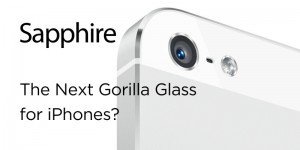Share This
Related Posts
Tags
Sapphire Glass
By Anca Gagiuc on Feb 28, 2014 in Technology
Apple’s highly-anticipated sapphire glass will not only offer super-protection to our favorite electronic devices, but will also improve battery life by the addition of solar-powered charging cells.
devices, but will also improve battery life by the addition of solar-powered charging cells.
Sapphire is one of the three gem-varieties of corundum, the other two being ruby – corundum in a shade of red – and padparadscha – a pinkish-orange. Although blue is the most common color, corundum can also be colorless or pink, green, and shades of gray and black. It can be mined or artificially produced.
Sapphire is more than a beautiful and extremely expensive gem. Because of its remarkable hardness – 9 on the Mohs scale, right after the diamond which scores the maximum 10 – sapphires are used in non-ornamental tasks such as infrared optical components (red ruby sapphires are utilized to create new-infrared lasers due to their capacity to be turned to the appropriate wavelengths, because of the titanium and chromium impurities that form them), high durability windows for high pressure diagnostic and scientific equipment, including bullet proof glass, wristwatch crystals and movement bearings, and scratch-resistant coverings for lenses and high-end watch faces (Rolex, Citizen, etc.) It is important to note that Corning Gorilla Glass scores ~7 on the Mohs scale.
Very high-end smartphones are already using sapphire crystal screens. The handmade Vertu Ti has a 3.7-inch crystal-covered screen, but thus far the technology has been too expensive for mass produced smartphone screens. Apple started using it to protect the cameras on the iPhone and, more recently, on the home button for the 5S model. But things are not about to stop here.
In a post on the Seeking Alpha investor blog, Matt Margolis concludes that the $578m deal Apple struck with GT Advanced Technologies has more than just the sapphire glass growth initiative behind it. The glass will be produced at Apple’s new 1.3 million square foot plant in Mesa, Ariz.
Connecting the dots between the combination of patents, job postings and equipment orders, leads to the theory that Apple, within the coming year, is developing the ability to engrave very precise channels in the underside of the protective sapphire coating that will be attached to the new iPhone and iPod Touch screens. Contained in the coating will be deposited compounds to create highly efficient solar cells to help charge the devices.
The company’s commitment to solar power is already well-known and raises high expectations; if we add Apple’s embrace of sapphire as primary material for its products, the resulted strategy is one sapphire-hard to break by competitors.
GT Advanced Technologies has recently been able to lower the cost for an iPhone screen’s worth from $15-18 to $3-5, and considering that $3 is the cost Apple is paying Corning for an iPhone Gorilla Glass covering, a big shift in the world of business is about to take place. However, according to Margolis, the main reason Apple is interested in the sapphire crystal has to be the need to protect all of their “cool stuff under the hood of their devices”.
Since a picture is worth a thousand words (and a video a few thousand more), the video below is from the Mobile World Congress 2013 in Barcelona; months later, GT Advanced Technologies joined the Apple family.
There have been numerous times over the years of Apple investing in expensive equipment to produce designs impossible to be copied by other companies. The sapphire glass could be that giant step very difficult if not impossible to take to keep up with the evolution of the technology. For eager consumers, the question is whether they’ll wait until September or stick to a June-July product intro for iPhone 6.
